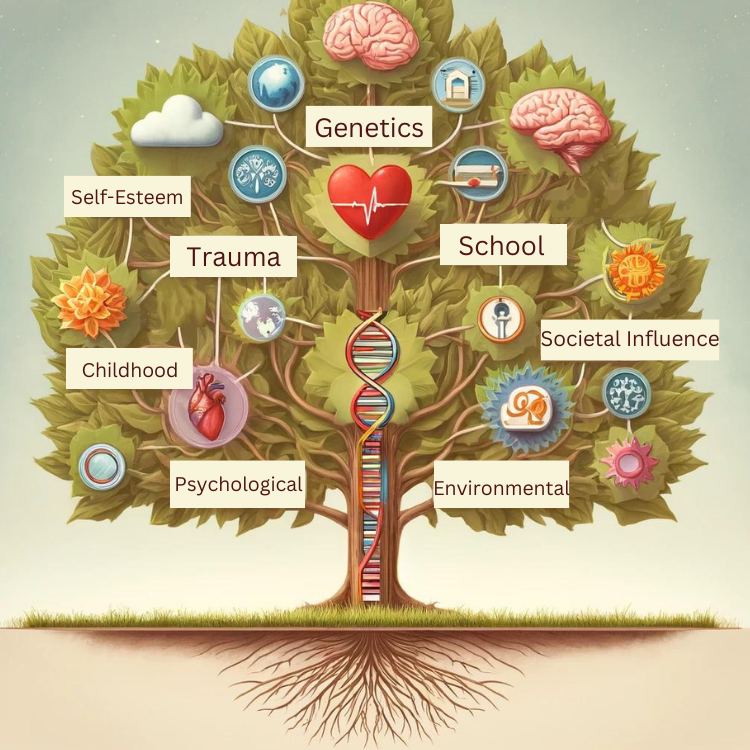- How you know you are dealing with a Narcissist: Signs of Narcissism
- What is Narcissistic Personality Disorder (NPD)?
- Unveiling the Signs of Narcissism
- 1. Constant Need for Attention
- 2. Perfectionism
- 3. Desire for Control
- 4. Blame Shifting
- 5. Lack of Boundaries
- 6. Empathy Deficit
- 7. Perception of Threats
- 8. Decision Making Based on Emotion
- 9. Split Personality
- 10. Fear of Ridicule
- 11. Guiltlessness
- 12. Inability to Love
- 13. Communication and Teamwork
- Psychological Underpinnings of Narcissistic Behaviors
- Managing Relationships with Narcissists
- Treatment and Management of Narcissistic Personality Disorder (NPD)
- Personal Stories and Case Studies
- Comparative Analysis with Other Personality Disorders
- Causes of Narcissism
- Societal Impact of Narcissism
- Unveiling the Signs of Narcissism
- In Conclusion to Understanding Narcissism
- Frequently Asked Questions About Narcissism
- What is Narcissistic Personality Disorder (NPD)?
- What are the signs of a narcissist?
- How is NPD diagnosed?
- Can narcissism be treated?
- What causes Narcissistic Personality Disorder?
- How does narcissism affect relationships?
- Is there a link between narcissism and other mental health issues?
- What can I do if I think a loved one has NPD?
- How can I cope if I have a narcissistic parent?
- What’s the difference between healthy self-esteem and narcissism?
- Further Reading and Resources
- Frequently Asked Questions About Narcissism
How you know you are dealing with a Narcissist: Signs of Narcissism
When it comes to identifying narcissistic traits and dealing with a possible narcissist, it’s often like the classic duck test: if it looks like a duck and quacks like a duck, it’s probably a duck. However, unlike diagnosing a common cold, there’s no straightforward blood test or MRI scan for narcissism. Instead, therapists rely on keen observations of behaviors and attitudes.
Don’t forget to take our free quiz here: Are You in a Relationship with a Narcissist: Quiz
Introduction to NPD
Narcissistic Personality Disorder (NPD) is a complex and often misunderstood condition characterized by an inflated sense of self-importance, a deep need for excessive attention and admiration, coupled with a lack of empathy for others. But the implications of narcissism extend beyond mere self-centeredness. It influences interpersonal relationships, workplace dynamics, and broader societal interactions in profound ways.
This article delves into the subtle yet distinct signs of narcissism, providing a roadmap for identifying narcissistic behaviors in various settings. We explore the psychological underpinnings that contribute to the development of NPD, offering insights into both its overt and covert manifestations. From personal relationships to professional environments, understanding these signs can empower individuals to manage interactions more effectively and protect their well-being from the often toxic impacts of narcissistic abuse.
Additionally, we will examine the causes of narcissism, discuss effective strategies for managing relationships with narcissists, and consider the broader societal impacts of these behaviors. Whether you are dealing with a narcissistic individual or seeking to understand this personality disorder better, this guide will equip you with the knowledge and tools necessary for insightful engagement with this challenging personality trait.
Let’s delve into the intricate world of narcissism, exploring the signs and behaviors that may indicate narcissistic personality disorder (NPD).

What is Narcissistic Personality Disorder (NPD)?
Narcissistic Personality Disorder is a clinically diagnosed condition characterized by grandiosity, an insatiable need for admiration, and a lack of empathy towards others. Essentially, it’s the belief that one is superior to everyone else. While NPD is the extreme end of the spectrum, individuals can exhibit narcissistic traits without meeting the full diagnostic criteria.
Unveiling the Signs of Narcissism
Here are some key behaviors and traits commonly associated with narcissism and narcissists:
1. Constant Need for Attention
- Narcissists crave attention and validation, often seeking it through various means, even if it means inconveniencing others.
2. Perfectionism
- Everything must be flawless in the narcissist’s world, including themselves and those around them.
3. Desire for Control
- Narcissists have an overwhelming need to control situations and people, stemming from a deep sense of entitlement.
4. Blame Shifting
- They evade responsibility by shifting blame onto others, refusing to acknowledge their own shortcomings.
5. Lack of Boundaries
- Narcissists have a distorted view of boundaries, believing everything and everyone is theirs to control.
6. Empathy Deficit
- They struggle to empathize with others, often viewing them as mere extensions of themselves.

7. Perception of Threats
- Narcissists are hypersensitive to perceived threats, often misinterpreting neutral or positive expressions as negative.
8. Decision Making Based on Emotion
- Their decisions are primarily driven by emotions, seeking external validation to fulfill their needs.
9. Split Personality
- Narcissists have a tendency to split their personality into good and bad parts, attributing negative traits to others while claiming credit for positive aspects.
10. Fear of Ridicule
They live in constant fear of being ridiculed or rejected, projecting their insecurities onto others.
11. Guiltlessness
Due to their belief in their infallibility, narcissists often lack guilt and bury their insecurities deep within.
12. Inability to Love
Their inability to understand emotions and empathize hinders genuine emotional connections.
13. Communication and Teamwork
They struggle to communicate effectively or work as part of a team, as their focus remains on self-preservation.
Psychological Underpinnings of Narcissistic Behaviors
Understanding the psychological underpinnings of narcissistic behaviors is crucial in grasping why these traits manifest so distinctly in some individuals. This section explores the deep-seated reasons behind the common narcissistic behaviors listed above, providing a clearer connection to their developmental origins.

- Constant Need for Attention and Validation: Often rooted in profound feelings of insecurity and low self-esteem, narcissists mask their deficits by seeking constant validation from their external environment. Their self-worth is significantly dependent on others’ admiration, reflective of an unstable self-image that relies heavily on external sources.
- Perfectionism and Control: Narcissists’ compulsive need for control and perfectionism can be traced back to a chaotic or unpredictable home environment during their formative years. By controlling their surroundings, they attempt to recreate a semblance of the security they lacked in childhood.
- Blame Shifting and Lack of Boundaries: These behaviors may develop from early relational dynamics where admitting fault was unsafe or met with harsh criticism. Consequently, narcissists learn to externalize faults while violating boundaries as a form of dominance and self-preservation.
- Empathy Deficit and Inability to Love: The apparent lack of empathy is often a protective mechanism against vulnerability. If emotional availability was exploited in their early relationships, narcissists might shut down empathic attunements to shield themselves from perceived threats or emotional demands.
- Split Personality and Fear of Ridicule: The splitting of the self into ‘all-good’ or ‘all-bad’ facets helps narcissists manage internal conflicts and preserve their idealized self-image. Their acute fear of ridicule is closely tied to a fragile ego that is highly sensitive to criticism.
- Decision Making Based on Emotion: Emotional decision-making is indicative of their reliance on external validation paired with an inability to cultivate a robust, internal moral and decision-making framework. This behavior mirrors the emotional dysregulation often seen in early developmental stages.
By integrating these psychological insights, we can see how narcissistic behaviors are not merely erratic traits but are deeply intertwined with past experiences and emotional injuries. This understanding allows for a more empathetic view of narcissism as a complex interplay of protective self-structures that have maladaptively evolved.
Managing Relationships with Narcissists
Navigating relationships with narcissists, whether they’re family members, friends, or colleagues, can be challenging and emotionally draining. Understanding how to interact effectively with narcissists can help you maintain your mental well-being while mitigating potential conflicts. Here, we provide practical advice for dealing with narcissists in various contexts, ensuring that you are prepared and protected in any interpersonal dynamics that involve narcissistic behaviors.
Setting and Maintaining Healthy Boundaries
Why Boundaries Are Crucial: Narcissists often do not recognize personal space and may frequently overstep boundaries. Setting firm boundaries is essential to protect your emotional health and signal to the narcissist what is and isn’t acceptable behavior.
Tips for Setting Boundaries:
- Be Clear and Consistent: Clearly communicate your limits in simple, unambiguous terms. Once these limits are set, enforce them consistently.
- Stay Calm and Resolute: When a narcissist tests your boundaries, maintain a calm demeanor and reassert your limits without emotion, which can help prevent escalation.
- Seek Support: It can be challenging to keep boundaries without support. Lean on trusted friends or therapists to strengthen your resolve.

Communication Strategies to Avoid Conflict
Effective Communication Techniques:
- Use ‘I’ Statements: Frame your discussions around how you feel and what you need, rather than what the narcissist is doing wrong. This can minimize defensiveness and misunderstandings (e.g., “I feel upset when I am interrupted because it makes me feel like my opinions are not valued”).
- Choose Your Battles Wisely: Not all issues are worth confronting. Sometimes, disengaging or changing the subject can be more beneficial than addressing a minor offense.
- Practice Empathetic Listening: Try to understand the narcissist’s perspective without necessarily agreeing. This can help de-escalate conflicts and communicate that you respect their viewpoint.
Knowing When to Seek Professional Help
Indications for Professional Intervention:
- Feeling Overwhelmed: If interactions with the narcissist consistently leave you feeling depressed, anxious, or hopeless.
- Impact on Life Quality: When the relationship starts to significantly impact your work, other relationships, or overall happiness.
- Physical Symptoms: High levels of stress can manifest physically, such as insomnia, headaches, or stomach issues.
Types of Professional Support:
- Therapy or Counseling: A mental health professional can help you build resilience and devise strategies specific to your situation.
- Support Groups: Joining groups, such as those for co-dependents or family members of narcissists, can provide understanding and coping strategies.
- Legal Advice: If boundaries are repeatedly disrespected and you feel unsafe, consulting a legal professional might be necessary.
Treatment and Management of Narcissistic Personality Disorder (NPD)
Treating Narcissistic Personality Disorder (NPD) can be complex and requires a nuanced approach. Individuals diagnosed with NPD or those involved in their care can find hope in several effective psychotherapy methods and emerging treatments. This section offers an overview of the current therapeutic options for NPD, highlights the inherent challenges in treating the disorder, and explores the latest research and approaches in the field.

Psychotherapy Options for NPD
Cognitive Behavioral Therapy (CBT): CBT is a popular psychotherapeutic treatment that helps individuals identify and challenge distorted thoughts and behaviors. In the context of NPD, CBT focuses on reducing problematic traits such as entitlement and sensitivity to criticism, and enhancing empathy through practical exercises.
- Techniques Used: Cognitive restructuring to address maladaptive thinking patterns, and behavioral experiments to modify behaviors.
- Goal: Increase emotional regulation, reduce impulsivity, and improve social functioning.
Psychodynamic Therapy: This therapy delves into the unconscious mind to uncover deep-seated fears and conflicts rooted in early developmental stages. It’s particularly adept at addressing the emotional turmoil and vulnerabilities masked by the narcissistic facade.
- Techniques Used: Exploration of past experiences, identification of defense mechanisms, and resolution of internal conflicts.
- Goal: Foster self-awareness and insight into one’s own behaviors and impacts on others.
Challenges in Treating NPD
Resistance to Therapy: Individuals with NPD often enter therapy due to external pressures (legal issues, relationship problems) rather than a voluntary desire for self-improvement, leading to resistance and low motivation.
Prognosis: The prognosis for NPD can vary significantly. Some individuals may achieve considerable improvement, while others may see less change due to the chronic nature of the disorder.
Therapist’s Role: Therapists must navigate the patient’s fragile self-esteem, potential hostility, and possible lack of commitment to the therapeutic process while trying to establish a therapeutic alliance.
Emerging Research and Therapeutic Approaches
Schema Therapy: An innovative approach that combines elements of CBT, psychodynamic, and attachment theories to change long-standing patterns or schemas. Schema therapy is promising for treating NPD, focusing on emotional needs that were not met in childhood and modifying maladaptive coping methods.
Mindfulness and Meditation: Recent studies suggest mindfulness practices can help narcissists reduce egocentrism, increase empathy, and improve emotional regulation.
Group Therapy: Although challenging, group therapy can be effective for individuals with NPD by providing feedback from peers in a controlled setting, which can mirror and challenge their perceptions and behaviors.

Personal Stories and Case Studies
Anecdotal evidence and case studies are powerful tools for understanding Narcissistic Personality Disorder (NPD) beyond clinical descriptions. They provide real-world insights and humanize the disorder, helping to reduce stigma and offer relatable experiences for those dealing with narcissists. This section features anonymized stories from various perspectives to illuminate the complexities of NPD and the efficacy of different management strategies.
Success Stories from Individuals
Case Study 1: Overcoming Family Dynamics
- Background: Jane, a 34-year-old woman, struggled with her father’s narcissistic traits throughout her childhood which affected her self-esteem and relationships.
- Approach: With the help of therapy, Jane learned to set boundaries and manage expectations. Family therapy sessions were instrumental in facilitating understanding and behavioral changes.
- Outcome: Improved family relationships and personal growth. Jane reports a significant decrease in familial tension and an increase in her own emotional resilience.
Case Study 2: Navigating a Professional Environment
- Background: Tom, a 45-year-old middle manager, dealt with a narcissistic boss who undermined and overworked him.
- Approach: Tom adopted strategies from cognitive behavioral therapy to manage interactions with his boss, focusing on maintaining professionalism and detaching from emotional responses.
- Outcome: Tom successfully advocated for a departmental transfer and now enjoys a healthier work environment and better mental health.

Therapists’ Perspectives on Treating NPD
Narrative from Dr. Alisha M., a Psychologist Specializing in Personality Disorders
- Experience: Over 15 years of treating clients with NPD, Dr. Alisha has used a combination of psychodynamic therapy and schema therapy to address their deep-seated issues.
- Insights: She emphasizes the importance of consistency in therapy and the therapist’s role in gently confronting the narcissistic defenses while building a relationship based on understanding and respect.
- Key Takeaway: Progress is possible, and therapy can lead to significant improvements in how individuals with NPD relate to others and view themselves.
Long-term Management of Narcissistic Traits
Longitudinal Case Study: Managing a Romantic Relationship
- Background: Sarah and Mike, where Mike has diagnosed NPD, have been in a relationship for ten years.
- Management Strategy: They regularly attend couples therapy, where they focus on communication techniques and empathy exercises.
- Progress: While challenges remain, the couple has seen a noticeable improvement in understanding and handling conflicts, attributing their success to ongoing therapy and commitment to personal growth.
Comparative Analysis with Other Personality Disorders
Narcissistic Personality Disorder (NPD) often coexists or is confused with other personality disorders due to overlapping traits. Understanding these similarities and differences is crucial for accurate diagnosis and effective treatment. This section provides a comparative analysis of NPD with two common personality disorders: Borderline Personality Disorder (BPD) and Antisocial Personality Disorder (ASPD).
NPD vs. Borderline Personality Disorder (BPD)
Key Differences in Symptoms:
- Emotional Regulation: Individuals with BPD experience intense emotional instability and fear of abandonment, whereas those with NPD typically display emotional fluctuations in response to threats to their self-esteem.
- Relationship Dynamics: BPD is characterized by a pattern of unstable interpersonal relationships, self-image, and affects, often swinging from intense closeness to extreme dislike. In contrast, NPD involves stable but superficial relationships where others are seen as extensions of themselves to bolster self-esteem.
Causes:
- Developmental Trajectories: The development of BPD is often linked to early childhood trauma and abandonment, contributing to poor emotional regulation. NPD, however, is more commonly associated with excessive pampering or unrealistic expectations from parents, leading to fragile self-esteem.
Treatment Options:
- Therapeutic Approaches: BPD treatments often focus on dialectical behavior therapy (DBT) which emphasizes managing emotions and improving relationships. NPD treatment typically involves cognitive behavioral therapy (CBT) aimed at reducing entitlement, increasing empathy, and improving interpersonal dynamics.

NPD vs. Antisocial Personality Disorder (ASPD)
Key Differences in Symptoms:
- Empathy and Lawfulness: While both disorders involve a lack of empathy, individuals with ASPD tend to violate societal norms and laws, often engaging in criminal behaviors, which is less characteristic of NPD.
- Manipulation Tactics: Narcissists manipulate others to gain admiration and favor, whereas those with ASPD manipulate to gain material benefits or fulfill self-serving motives without regard for others’ rights.
Causes:
- Genetic and Environmental Influences: ASPD is strongly influenced by genetic predispositions and environmental factors such as child abuse and neglect. NPD is also influenced by upbringing, particularly the type and style of parenting received, with less emphasis on genetic factors.
Treatment Options:
- Responsiveness to Treatment: Treatment for ASPD focuses on behavior management and is notoriously difficult, given the person’s lack of remorse. In contrast, individuals with NPD can sometimes respond to psychotherapy, especially when issues like depression or anxiety coexist.
Overlap and Differential Diagnosis
Overlap in Traits:
- Both NPD and BPD individuals might exhibit superficial charm and a manipulative nature; NPD to maintain a facade of superiority, BPD as an unstable response to perceived threats to security.
- NPD and ASPD share traits like arrogance and a propensity to exploit others, though their underlying motivations differ.
Professional Diagnosis:
- Differential Diagnosis: Mental health professionals use specific criteria from the Diagnostic and Statistical Manual of Mental Disorders (DSM-5) to differentiate between these disorders. This includes evaluating the individual’s history, symptom intensity, and the primary motivations behind their behaviors.

Causes of Narcissism

While the exact causes of NPD remain elusive, several factors may contribute to its development:
1. Genetics
There may be a genetic predisposition to NPD, particularly in individuals with a family history of personality disorders.
2. Childhood Experiences
Traumatic or critical experiences during childhood can shape narcissistic traits as coping mechanisms.
3. Societal Influence
Societal norms that emphasize competitiveness and success may fuel narcissistic tendencies.
4. Trauma
Emotional trauma or abuse can lead individuals to adopt narcissistic behaviors as a defense mechanism.
5. Psychological Factors
Fragile self-esteem, insecurities, and a lack of empathy may contribute to the development of narcissistic traits.

Societal Impact of Narcissism
Narcissism, particularly when it manifests in leadership and cultural trends, has profound implications for societal structures and norms. This section explores how narcissistic traits influence various domains, including corporate environments, political arenas, and broader cultural contexts, and examines the interplay between narcissism and modern technologies like social media.
Narcissism in Leadership Roles
Impact on Organizational Culture and Ethics:
- Corporate Governance: Narcissistic leaders often foster a top-down, authoritarian corporate culture that prioritizes results over ethical considerations. This can lead to unethical behaviors, risky decision-making, and a lack of accountability.
- Employee Relations: Such leaders may also create environments rife with competition and minimal collaboration, leading to decreased morale and increased burnout among employees.
- Innovation vs. Sustainability: While narcissistic leaders are often charismatic and can drive bold initiatives, their focus on grandiose success might undermine sustainable practices and long-term planning.
Healthy Self-Esteem vs. Narcissistic Behavior in Success
Balancing Self-Perception:
- Healthy Self-Esteem: Involves confidence and a realistic appraisal of one’s abilities and limitations, contributing positively to personal achievements and interpersonal relationships.
- Narcissistic Behavior: By contrast, involves an inflated sense of self-importance and entitlement, often disconnecting individuals from realistic feedback and genuine personal growth.
Achieving Success:
- Professional Environments: In workplaces, a certain degree of self-confidence is necessary, but the thin line between confidence and narcissism can determine the health of organizational dynamics.
- Personal Relationships: In personal spheres, those with narcissistic tendencies might initially succeed in social manipulations; however, these relationships often suffer from lack of depth and genuine connection over time.

Role of Social Media and Technology
Amplification of Narcissistic Tendencies:
- Visibility and Validation: Social media platforms provide immediate and often uncritical validation in the form of likes and comments, reinforcing narcissistic behaviors.
- Self-Presentation: The ability to curate an idealized image of oneself on digital platforms can exacerbate narcissistic traits, encouraging a focus on superficial qualities rather than genuine self-improvement.
- Echo Chambers: Social media can also create echo chambers where users receive information that reinforces their beliefs and desires, which can further entrench narcissistic worldviews.
In Conclusion to Understanding Narcissism
Identifying narcissistic traits is crucial for understanding and navigating relationships. While this guide provides insights into common behaviors associated with narcissism, it’s important to remember that it’s not a substitute for professional diagnosis or treatment. By recognizing these signs, individuals can better protect themselves and seek support when needed.
Remember, understanding narcissism empowers individuals to foster healthier relationships and cultivate greater self-awareness.
Frequently Asked Questions About Narcissism

What is Narcissistic Personality Disorder (NPD)?
Narcissistic Personality Disorder is a mental condition characterized by a long-term pattern of exaggerated self-importance, a deep need for excessive attention and admiration, troubled relationships, and a lack of empathy for others. However, behind this mask of extreme confidence lies a fragile self-esteem that’s vulnerable to the slightest criticism.
What are the signs of a narcissist?
Key signs of a narcissist include:
- A grandiose sense of self-importance
- Preoccupation with fantasies of unlimited success, power, brilliance, beauty, or ideal love
- Belief they are special and unique and can only be understood by, or should associate with, other special or high-status people or institutions
- Need for excessive admiration
- Sense of entitlement
- Interpersonally exploitative behavior
- Lack of empathy
- Envy of others or belief that others are envious of them
- Demonstrative arrogant, haughty behaviors or attitudes
How is NPD diagnosed?
NPD is diagnosed based on a psychological evaluation that assesses the history and severity of symptoms. Health professionals use the criteria outlined in the Diagnostic and Statistical Manual of Mental Disorders (DSM-5), published by the American Psychiatric Association.
Can narcissism be treated?
Yes, narcissism can be treated with psychotherapy, also known as talk therapy. There is no cure for NPD, but therapy can help individuals learn to relate better with others so they can have more rewarding relationships, understand and regulate their feelings, tolerate criticisms or failures better, and be more self-aware.
What causes Narcissistic Personality Disorder?
The exact cause of NPD isn’t known. However, it’s believed to result from a combination of factors, including genetic, environmental, and psychological factors. These might include excessive adulation or excessive criticism during childhood, an unpredictable or unreliable caregiving from parents, and inherited genetic defects.
How does narcissism affect relationships?
Narcissists often struggle to form healthy, balanced relationships. They may form relationships primarily to bolster their ego and to use as a tool to meet their own needs and ignore others’ needs. This can cause significant distress to both parties and make mutual satisfaction and healthy emotional connection difficult.
Is there a link between narcissism and other mental health issues?
Yes, NPD can be associated with other mental health disorders such as depression, substance abuse, or other personality disorders. The presence of co-occurring disorders is generally a complication that can exacerbate the symptoms and treatment complexity of NPD.
What can I do if I think a loved one has NPD?
Encourage them to seek a comprehensive evaluation from a psychologist or psychiatrist. Treatment, often involving psychotherapy, can help, and in some cases, medication might be recommended to treat associated symptoms like depression or anxiety. However, be prepared for denial and resistance to treatment as self-awareness is often low in narcissists.
How can I cope if I have a narcissistic parent?
Coping with a narcissistic parent involves setting clear boundaries, protecting your self-esteem, seeking external support from friends or therapists, and possibly limiting contact if the relationship is too toxic. Focus on building your own emotional strength and resilience.
What’s the difference between healthy self-esteem and narcissism?
Healthy self-esteem and narcissism differ primarily in the extent to which individuals value themselves relative to others. Healthy self-esteem involves confidence and a balanced appreciation of one’s own worth and abilities without belittling others. In contrast, narcissism involves a disproportionate level of self-worship, which often comes at the expense of others and is accompanied by a lack of empathy.
Further Reading and Resources
To deepen your understanding of Narcissistic Personality Disorder (NPD) and related personality disorders, we recommend the following books, articles, and websites. These resources provide valuable insights and extended knowledge to help individuals, families, and professionals handle narcissism effectively.
Books
- “The Wizard of Oz and Other Narcissists” by Eleanor D. Payson, MSW
- A practical guide to recognizing and dealing with the narcissistic personalities in your life. Amazon Link
- “Disarming the Narcissist: Surviving and Thriving with the Self-Absorbed” by Wendy T. Behary, LCSW
- This book offers effective strategies for dealing safely with someone who is at the center of his or her own universe. Amazon Link
- “Why Is It Always About You? : The Seven Deadly Sins of Narcissism” by Sandy Hotchkiss
- Sandy Hotchkiss explains how to cope with controlling, egotistical people who are incapable of the fundamental give and take that sustains healthy relationships. Amazon Link

Articles
- “Understanding Narcissism and the Possibilities for Healing” by Kenneth N. Levy, Ph.D.
- Published on Psychology Today, this article explores the roots of narcissistic behavior and therapeutic approaches for healing. Read Here
- “Narcissistic Personality Disorder” by Mayo Clinic
- A comprehensive overview of NPD provided by one of the leading healthcare institutions. Read Here
- “The Role of Narcissism in Aggression and Violence: A Review of the Literature”
- This article from the Wiley Online Library provides insights into the link between narcissistic traits and aggressive behaviors. Read Here
Websites
- Psychology Today – Narcissism
- A portal to numerous articles, blogs, and therapist resources focusing on narcissism. Visit Here
- National Alliance on Mental Illness (NAMI)
- Offers support, education, and advocacy for anyone affected by mental illnesses, including NPD. Visit Here
- Mental Health America (MHA)
- Provides comprehensive information on various mental health conditions and coping strategies, including resources for dealing with narcissism. Visit Here
- Are You in a Relationship with a Narcissist: Quiz
- Welcome to BPD Land: The Ultimate Roller Coaster Ride
- Breaking Free: A Journey Through Addiction and Recovery
- ADHD & ADD: Thrive, Not Just Survive
- Navigating the Bipolar Journey: Mastering Mood Swings
- When Relationship Problems Cause Anxiety: Relationship Anxiety
















I was recommended this website by my cousin I am not sure whether this post is written by him as nobody else know such detailed about my trouble You are amazing Thanks